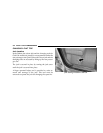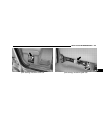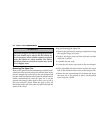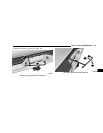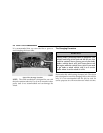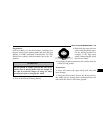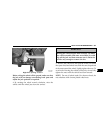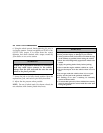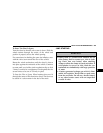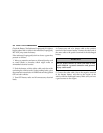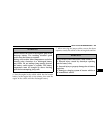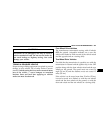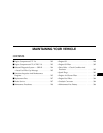
6. Using the wheel wrench, finish tightening the nuts in
a crisscross pattern. Correct nut tightness is 85-115 ft. lbs.
(115-155 N·m) torque. If in doubt about the correct
tightness, have them checked with a torque wrench by
your dealer or at a service station.
WARNING!
A loose tire or jack thrown forward in a collision or
hard stop could injure someone in the vehicle.
Always stow the jack, tools and the extra tire and
wheel in the places provided.
7. Lower the jack to its fully closed position. Stow the
replaced tire, jack, and tools as previously described.
8. Adjust the tire pressure when possible.
NOTE: Do not oil wheel studs. For chrome wheels, do
not substitute with chrome plated wheel nuts.
WARNING!
Carefully follow these tire changing warnings to help
prevent personal injury or damage to your vehicle:
•
Always park on a firm, level surface as far from the edge
of the roadway as possible before raising the vehicle.
• Block the wheel diagonally opposite the wheel to be
raised.
• Apply the parking brake firmly before jacking.
• Never start the engine with the vehicle on a jack.
• Do not let anyone sit in the vehicle when it is on a
jack.
• Do not get under the vehicle when it is on a jack.
• Only use the jack in the positions indicated.
• If working on or near a roadway, be extremely
careful of motor traffic.
• To assure that spare tires, flat or inflated are securely
stowed, spares must be stowed with the value stem
facing the ground.
282 WHAT TO DO IN EMERGENCIES



